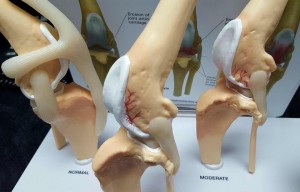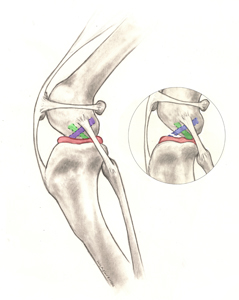 At Guildford Animal Hospital we strive to offer proven, cutting-edge treatments for your pets. Because we want to ensure that our patients receive the best possible outcome, all of our orthopedic surgeries are referred to a Board Certified Veterinary Surgeon…a veterinarian who has completed an additional 2-3 year surgical residency and is then certified by the American College of Veterinary Surgeons.
At Guildford Animal Hospital we strive to offer proven, cutting-edge treatments for your pets. Because we want to ensure that our patients receive the best possible outcome, all of our orthopedic surgeries are referred to a Board Certified Veterinary Surgeon…a veterinarian who has completed an additional 2-3 year surgical residency and is then certified by the American College of Veterinary Surgeons.
By far, the most common orthopedic surgery we make referrals for at our hospital involves the treatment of the Cranial Cruciate Ligament Tear in dogs. To treat this, a Board Certified Veterinary Surgeon will most commonly perform a TPLO (Tibial Plateau Leveling Osteotomy) which alters the geometry and biomechanics of the knee. This surgery is far superior to all other methods or treating a torn Cranial Cruciate Ligament in dogs in that it offers the fastest recovery time and the least complications. Although recovery involves post-operative restriction of activity for 8 weeks, we commonly see dogs wanting to use their surgical leg just a few hours after surgery!
Here we provide all the information you could ever want about TPLO Surgery for dogs. This is a huge amount of information so please don't hesitate to reach out to our team if you have any questions about your pet’s condition or surgical recommendations.
OVERVIEW OF CRANIAL CRUCIATE DISEASE
The cranial cruciate ligament (CrCL, see Figure 1.) is one of the most important stabilizers inside the canine knee (stifle) joint, the middle joint in the back leg. In humans the CrCL is called the anterior cruciate ligament (ACL).

Illustration of the anatomy of the dog’s knee: Blue = cranial cruciate ligament; Red = meniscus; Green = caudal cruciate; the insert shows a ruptured cranial cruciate ligament (also note that the shinbone is displaced forward and is crushing the meniscus). The meniscus is a ‘cartilage-like’ pad that sits in between the femur (thigh) and tibia (shin) bones. It serves many important purposes in the joint such as shock absorption, position-sensing, and load-bearing and can be damaged when the CrCL is ruptured.
Rupture of the CrCL is one of the most common reasons for hind limb lameness, pain, and subsequent knee arthritis. Since the development of this problem in dogs is much more complex than in humans, and they experience different degrees of rupture (partial or complete), the canine condition is referred to as ‘cranial cruciate ligament disease’ (CrCLD). While the clinical signs (symptoms) associated with CrCLD vary, the condition invariably causes rear limb dysfunction and pain.
Most commonly CrCLD is caused by a combination of many factors, including aging of the ligament (degeneration), obesity, poor physical condition, genetics, conformation (skeletal shape and configuration), and breed. With CrCLD, ligament rupture is a result of subtle, slow degeneration that has been taking place over a few months or even years rather than the result of acute (sudden) trauma to an otherwise healthy ligament (which is very rare). This difference between people and dogs explains two important features of canine CrCLD:
- 40-60% of dogs that have CrCLD in one knee will, at some future time, develop a similar problem in the other knee.
- Partial tearing of the CrCL is common in dogs and progresses to a full tear over time.
Cranial cruciate ligament disease can affect dogs of all sizes, breeds, and ages, but rarely cats. Certain dog breeds are known to have a higher incidence of CrCLD (Rottweiler, Newfoundland, Staffordshire Terrier, Mastiff, Akita, Saint Bernard, Chesapeake Bay Retriever, and Labrador Retriever) while others are less often affected (Greyhound, Dachshund, Basset Hound, and Old English Sheepdog). A genetic mode of inheritance has been shown for Newfoundlands and Labrador Retrievers.
Poor physical body condition and excessive body weight are risk factors for the development of CrCLD. Both of these factors can be influenced by pet owners. Consistent physical conditioning with regular activity and close monitoring of food intake to maintain a lean body mass is advisable.
SIGNS OF A CRUCIATE LIGAMENT TEAR IN YOUR PET
A typical history of a dog with a Cruciate Ligament tear is either:
- A sudden onset of severe non-weight bearing or “toe-touching” lameness of a hind leg, or
- Mild lameness of a hind leg for a week to months with or without a sudden worsening of this lameness
However, dogs with CrCLD may exhibit any combination of the following signs (symptoms):
- difficulty rising from a sit
- trouble jumping into the car
- decreased activity level
- lameness (limping) of variable severity
- muscle atrophy (decreased muscle mass in the affected leg)
- decreased range of motion of the knee joint
- a popping noise (which may indicate a meniscal tear)
- swelling on the inside of the shin bone (fibrosis or scar tissue)
- pain
- unwillingness to play
- stiffness
DIAGNOSING A CRUCIATE LIGAMENT TEAR
Diagnosing complete tears of the CrCL is easily accomplished by the veterinarians at Guildford Animal Hospital using a combination of your pet’s history, gait observations, physical examination findings and radiography (X-rays). By contrast, partial CrCL tears may be more challenging to diagnose. Sedation and pain medication will often be required to relax larger or tense dogs so that their knees can be manipulated and diagnostic quality X-rays can be performed with minimal discomfort or stress.
X-rays of the knees allow us to:
- confirm the presence of joint effusion (fluid accumulation in the joint, indicating that there is an abnormality present)
- evaluate for the presence/degree of arthritis
- take measurements for surgical planning
- rule out concurrent disease conditions as serious as bone cancer that can present similarly
TREATMENT OF A CRUCIATE LIGAMENT TEAR IN YOUR PET
Surgical treatment is typically the best treatment for CrCLD since it is the only way to permanently control the instability present in the knee joint. Surgery addresses one of the main issues associated with CrCLD — knee instability and the pain it causes as a consequence of the loss of normal CrCL structural support.
The goal of the TPLO (Tibial Plateau Leveling Osteotomy) surgery is not to “repair” the CrCL itself. Due to biological and mechanical influences, the CrCL has no ability to heal once tearing begins regardless of the degree of severity. Unlike in human ACL surgery, the canine CrCL is not typically “replaced” with a graft. This fact is largely due to the major mechanical differences that exist between biped (human) and quadruped (canine) knees that make graft-based techniques less reliable in dogs. Stability of the knee joint is achieved without replacing the CrCL itself but rather by changing the biomechanics of the knee joint. This is accomplished by rotating the plateau (slope) of the shin bone.
If present concurrently, meniscal injury will be addressed by your surgeon by removing the damaged meniscal parts when performing surgery to stabilize the knee.
POST-OPERATIVE HOME CARE
Postoperative care at home is critical. Premature, uncontrolled or excessive activities risk complete or partial failure of any surgical repair. Such failure may require extensive surgery to address.
The long-term prognosis for animals undergoing surgical repair of CrCLD is good, with reports of significant improvement in 85-90% of the cases. However, arthritis can progress regardless of treatment type. Therefore, multimodal osteoarthritis management is recommended for any dog with CrCLD regardless of treatment. Each pet is different and any or all of the following options may be right for your pet’s situation:
- Weight management with a prescription diet such as Hill’s Metabolic Diet
- Inflammation management with a prescription diet such as Hill’s J/D Diet
- Cartrophen injections to optimize joint health
- Natural anti-inflammatory supplements such as Green Lipped Mussel or Salmon Oil
- Physiotherapy at home or at a rehabilitation facility
- Non-steroidal anti-inflammatory medications such as Metacam
Obesity in pets has numerous health issues associated with it that go beyond CrCLD. Weight loss should be considered critical to any overweight pet with CrCLD. At Guildford Animal Hospital we provide ongoing support with a free weight management assessment and program to ensure the best quality of life for your pets.